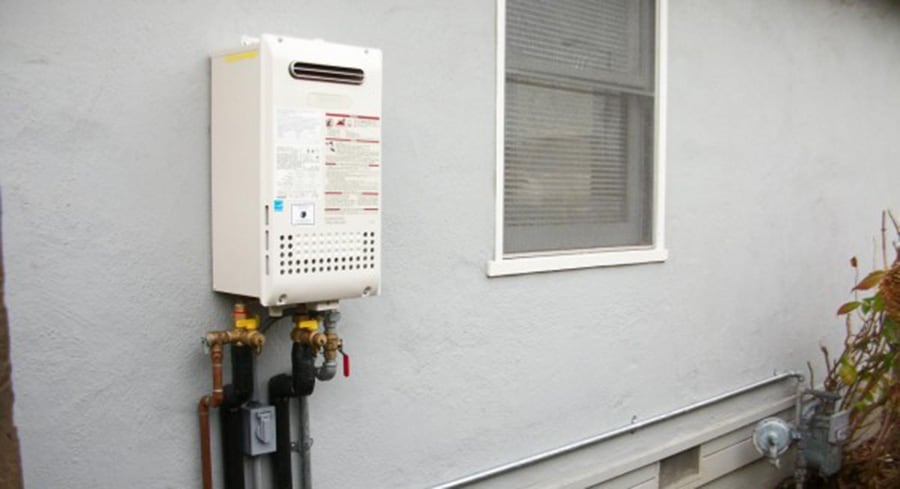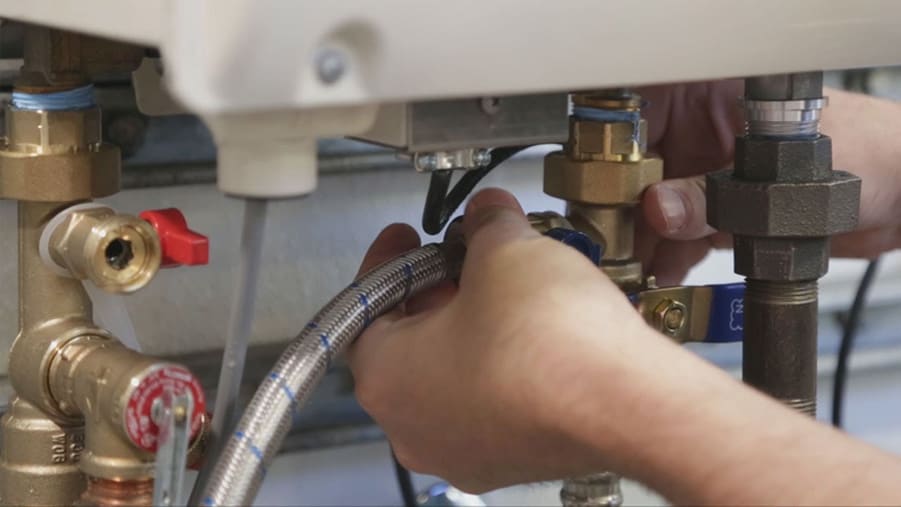
Tankless water heaters are typically installed outside against the house. This can make tankless water heaters particularly vulnerable in cold weather. While tankless water heaters don’t store large amounts of water like tank water heaters, they are still subject to freezing in cold weather.
If you own a tankless water heater, you may be concerned about freezing temperatures in cold weather. Most tankless water heaters have electric freeze prevention that protects critical internal parts against freezing temperatures from -5 to -22 degrees Fahrenheit. The built-in electric heaters need to be connected to work and won’t work in a power outage.
The electric freeze protection will not protect exterior piping and other components outside the tankless water heater itself. So additional protection will be needed to protect against freezing in extremely cold weather. See our article on top options to keep your tankless water heater running with no electricity.
If you’d like to know how to keep your tankless water heater safe in cold weather and what to do when the hot water stops running in the dead of winter, read on.
How a Tankless Water Heater can Freeze
Tankless water heaters installed outside typically freeze when standing water inside the heater is subjected to wintry conditions and the freezing temperatures that come with them.
As mentioned above, most indoor and outdoor tankless water heaters have built-in freeze protection against freezing temperatures that kick in when temperatures drop into the low 30s Fahrenheit and ranging from -5 to -22 degrees Fahrenheit over a brief time period.
These built-in protective devices alone will not protect the water heater pipes from freezing temperatures in the long term. If your tankless water heater is beeping, there could be a problem with the internal components due to the cold weather.
The built-in freeze protection in tankless water heaters run off electricity, and without a constant power source or in the event of a power failure, the devices will not function as they should.
Because water expands when it freezes, a tankless water heater exposed to freezing weather won’t just stop working ‒ the expanding water can actually damage the interior components and force you to pay for a costly repair.
6 Tips to Keep Your Tankless Water Heater from Freezing

Prevention is the best strategy when it comes to dealing with a frozen water heater. Fortunately, most tankless water heaters have built-in freeze protection. You’re only at risk for freeze damage if these safety mechanisms fail or malfunction.
Install your water heater in a warm area
While it’s not always possible, the best way to keep your water heater from freezing is to install it in a warm place. An indoor location away from the harsh winter elements is ideal, but even an outdoor heater can be strategically placed to minimize the cold effects. Here are a few tips for placing outdoor water heaters:
- Place the water heater somewhere away from the wind, which will decrease the effect of wind chill. You can block the wind with fencing or walls or place the heater in a wide hole to protect it from above-ground wind gusts.
- Install vent terminations that provide wind-resistant functionality.
Run a small stream of water through the tankless water heater
Water will typically only freeze if it is standing still. You can greatly reduce the risk of your tankless water heater freezing if you run a small, constant stream of water through the heater.
It doesn’t have to be a lot ‒ 0.1 to 0.2 gallons per minute should be enough to prevent freezing. You can accomplish this by slightly turning on a tap somewhere out of the way. While this might result in a small increase in your water bill, preventing a costly water heater repair bill will certainly be worth the additional cost.
Use of the built-in electric heaters
Many tankless water heaters have built-in electric freeze prevention heaters to stop standing water from turning into ice. While these heaters are effective when they’re functioning properly, you’ll need to make sure they’re plugged into a reliable power source. Without being attached to an external source of power, they won’t work.
Power failures are common in extreme cold temperatures or during winter storms. If you have a generator installed, be sure one of the circuits covered powers the built-in heater systems.
Another option would be to install a backup battery power source for your tankless water heater. These are often separate ancillary systems that aren’t installed unless requested.
Also, freeze prevention heaters are only effective down to as low as -22 degrees Fahrenheit. If you live somewhere that gets particularly cold during the winter, you may need to take other steps to ensure your tankless water heater doesn’t break down.
Winterize the tankless water heater
If your power goes out in cold weather or dealing with a water heater at a vacation home, and you’re going to be leaving for an extended period of time, you should drain the water from the heater. It will eliminate any chance of standing water freezing and damaging the internal components. You’ll also save money that would have otherwise been spent on preventative measures.
Some tankless water heaters have freeze protection solenoid valves installed. If your tankless water heater does not have these valves, you should consider having a plumber install them.
Freeze protection solenoid valves are always “open” and must have power for them the valve to close. If the power goes out, the valve opens and drains the tankless water heater automatically.
How to manually drain your tankless water heater
If your tankless water heater does not have the freeze protection solenoid valve kit installed, you will have to manually drain your system. To manually drain your tankless water heater.
- Turn off the gas supply
- Turn off the cold water supply
- Turn off the temperature control panel.
- Disconnect the electrical power to the water heater.
- Open the hot water tap at a sink inside the house before opening valves to release pressure in the pipes.
- Place a bucket under the water heater to catch the water.
- Remove the drain caps on the hot and cold isolation valves.
- Open the hot and cold isolation valves.
- Remove the cold water inlet filter and any drain caps at the bottom of the water heater.
Winterizing is a good time to also do tankless water heater maintenance.
Install a hot water recirculation system
If you live in a particularly cold climate, you might want to consider investing in a recirculation system. While these systems are usually installed to provide an instant source of hot water at a certain location, they also continuously engage your water heater and your pipes.
This will prevent your heater and pipes from freezing, but the additional expense probably isn’t worth it for most people. A recirculation system has other advantages, such as reducing the time for hot water to arrive at the fixtures farthest from the tankless water heater.
Keep in mind, when installing a recirculation pump and storage tank, your tankless water heater will need an expansion tank.
Insulate your water supply pipes
Your water heater isn’t the only thing water runs through. Your pipes are also at risk of freezing, and they don’t have the freeze prevention mechanisms that most tankless water heaters have.
If you’re unfamiliar with pipe insulation, here are a few materials you can use to protect your pipes from freeze damage effectively:
- Heat tape insulation
- Polyethylene insulation
- Fiberglass insulation
What to do if Your Tankless Water Heater Freezes?
Waking up to a seemingly frozen tankless water heater can be a bit scary. Access to hot water is especially important when it’s cold out, and that happens to be when your water heater is most likely to freeze.
So if you turn on a tap in the dead of winter and nothing but ice-cold water comes out, there’s no need to start panicking. There’s a good chance your water heater isn’t actually frozen.
But if it is, you’re probably in for a costly replacement, as most frozen water heaters cannot be used to heat the water again.
Check the water supply pipes
The first thing to check when you have no hot water is the pipes. It is far more likely that one of the pipes leading into or out of your water heater is frozen than it is for the heater itself to be frozen.
The most likely place to find a frozen pipe is the spot in which they enter and leave your house. This section of piping is most exposed to the elements and cold wind drafts that cause water to freeze, so you should check these for frozen standing water before doing anything else.
If you find a section of frozen piping, you need to act quickly. When frozen water expands, it can easily break most conventional plumbing materials. The easiest way to thaw a frozen pipe is to apply a steady stream of hot air to the frozen section. A hairdryer, space heater, or heat gun will all thaw the water relatively quickly.
You can also use the heating system in your house to help with the thawing process. Crank up the heat on your thermostat and open up areas containing pipes to let the heat get to them. Some common areas containing pipes include closets, cabinets, and storage rooms.
Combining local heat (a stream of air on the frozen section) with global heat (your home’s heating system) should be enough to thaw almost any frozen pipes you encounter.
Check the condition of your tankless water heater
If the pipes seem to be thawed and working as intended, you should check the water heater. A frozen heater is only likely if you’ve had a sustained power outage or have had the heater turned off for an extended period of time, which is why it’s unlikely a frozen heater will cause a sudden loss of hot water. That being said, it’s still possible, and it’s still something you need to check.
The easiest way to check if your heater is frozen is to open the drain valve. If a substantial amount of water comes out, the tank is not frozen. If the tank is on and seemingly operational, but no water flows out of the drain valve, there’s a decent chance the heater is filled with frozen water.
At this point, it might be possible to repair the heater, but you’re probably going to have to replace the whole thing. Frozen water will wreak havoc on the internal components of your heater, and it’s likely that simply buying a replacement will be cheaper than hiring someone to repair the damaged parts. Proper maintenance will help your tankless water heater last longer.







